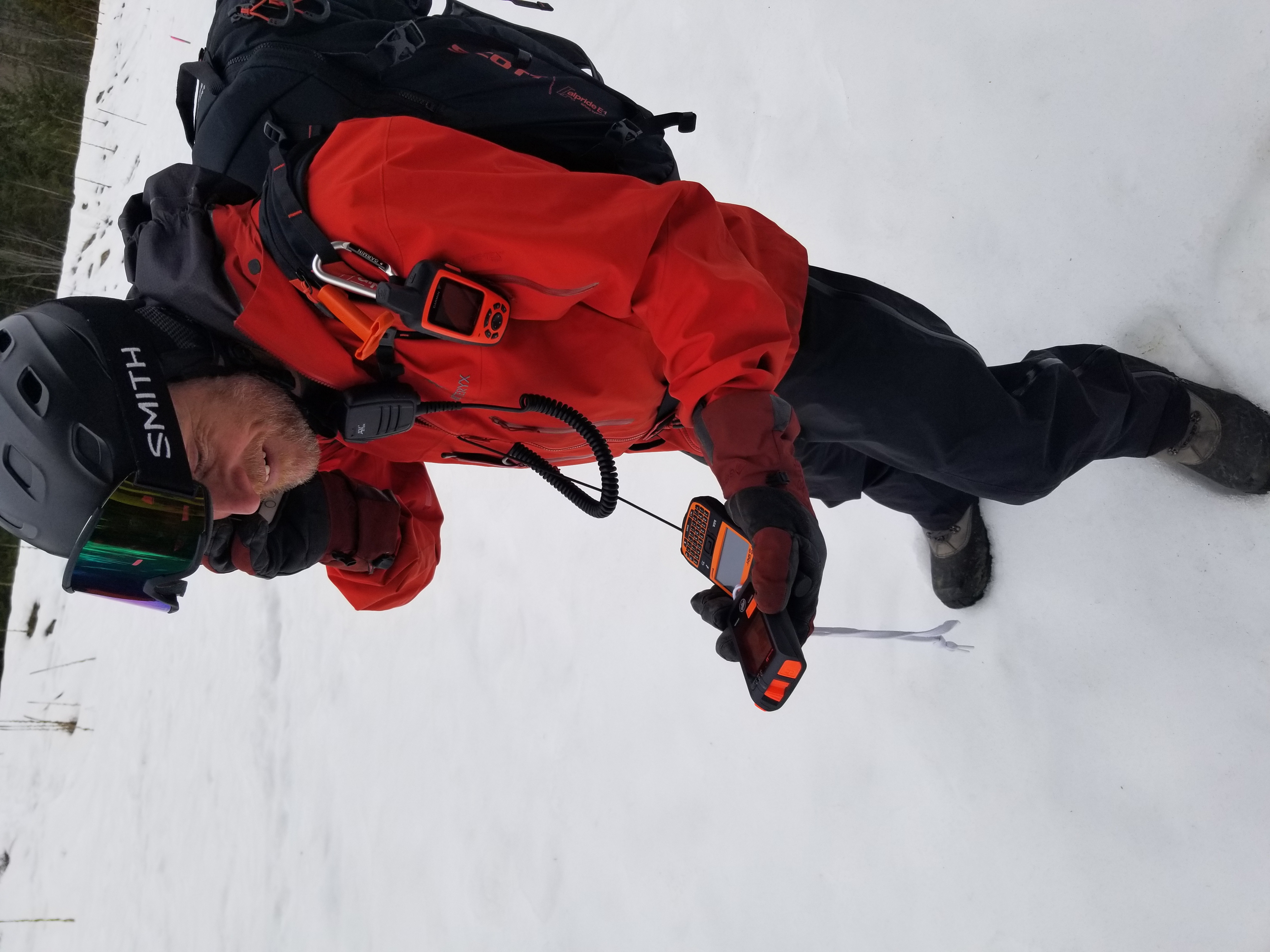- Date
- jeudi 9 décembre 2021
- Auteur
- Karl Klassen, Conseiller
We’ve long known that transceiver signals can be affected by metallic and electronic items. In our increasingly wired world, where we head into the backcountry with phones, video cameras, satellite communication devices, and more, this subject has become more important. With this in mind, I did some homework.

- Crédit
- Colin Garritty
A transceiver search can be quite challenging. Make your life easier by eliminating potential sources of interference.
First, I discovered that interference is generally described as being either “passive” or “active.” Passive interference blocks the transceiver’s signal, and it happens when the transceiver is too close to items made of metal or foil. I’ve often seen transceivers produce an error message or alert when someone was wearing it near or under a pocket that contained a candy bar with a foil wrapper or a metal water bottle (ok, truly, it was a whisky flask—but you get the idea).
One of my most memorable experiences with passive interference involved a regular one-metre transceiver check that showed no problems, but at about 10 metres the signal completely disappeared. Eventually we determined there was a layer of heat-reflective foil in the person’s jacket. When they took off the jacket the problem disappeared. (Yes, we did find them another jacket, so they didn’t have to ski in their underwear).
Active interference disturbs the transceiver’s signal. This occurs when the transceiver is too close to devices that use electricity, carry an electrical current, or transmit or receive electronic signals. The result of active interference is like static on the radio or a pixelated TV picture. The signal is distorted, which makes the transmitted information hard to understand.
These days, we’re surrounded by items that can present active interference. Heated jackets, gloves, and socks all have wires carrying an electrical current. Add mobile phones, GPS units, and satellite-enabled communications devices to the list. And don’t forget when we link our devices using a wired connection (attaching headphones to our phone) or wirelessly (pairing a GPS unit or SOS device to our phone via Bluetooth). All of these and more are potential sources of interference.

- Crédit
- Martina Halik
Interference—both passive and active—affects a transceiver’s send and search modes. Mitigating interference is not complicated while you’re in send mode. Keep all sources of interference, passive and active, at least 20 cm away from your transceiver. I personally shoot for 30 – 40 cm.
This means making some effort to ensure your transceiver stays in place, so it can’t get closer to any gear that might cause interference. This may require some modifications to your transceiver harness. I keep my transceiver on my right hip, in an inside pocket with a zipper closure. Anything I need ready access to, like my radio, goes in my top left jacket pocket. Electronics that don’t require quick access, like my GPS, SOS device, and phone, all go in the top pocket of my pack, on the left side.
If you are shooting POV video, wear your camera on your helmet or use a stick. A chest harness is a no-go (where I ski a chest harness is useless anyway—all you see is white all the time). Jackets with a heat-reflective foil liner are also a no go. Be careful—sometimes the foil is between the jacket shell and liner so it may not be visible. Heated socks are probably okay but heated jackets are definitely not. Heated or foil-lined gloves should be avoided because the transceiver is in your hand when you’re searching. If you use these types of gloves, they need to be taken off and stowed away during a search, so you better have a back-up pair.
When in search mode, you’ll need to increase the distance between your transceiver and sources of passive interference to 50 cm. This is not as big a deal as it might seem. Simply taking your transceiver out and holding it in front of you will likely be adequate. If you wear an electronic watch, you’ll need to take it off and store in your pack while searching.
The electrical engineers I talked to were most concerned about active interference in search mode. There are so many types of devices operating on various frequencies, the experts I consulted felt there is no realistic way to test all those combinations and configurations to come up with a standard approach to solving this problem.
The consensus advice was this: When it comes to active interference—items with an electrical current, or any type of signal like Wi-Fi, Bluetooth, GPS, or phone—the best approach is to turn these devices off when searching. Even when not in active use, many devices are actively searching for or receiving information, which can interfere with your transceiver. Even sleep mode, airplane mode, and other means of restricting functions does not guarantee your device is fully dormant, and interference remains possible.
In practically all cases, when you turn off an active source of interference it then becomes a passive source of interference and needs to be kept 50 cm away from your transceiver in search mode. So, after you’ve turned everything off, stash them in your pack before you begin searching. Turn off your heated socks and remember that in the fine search stage, when your transceiver is near the ground (and your feet), be aware that you’re getting close to the wiring and batteries.

- Crédit
- Curtis Pawliuk
Remember to turn off your heated socks so they don't cause interference during the fine search.
However, some electronics may be essential in some situations. You may want to use a phone or a radio to call for help or communicate with other rescuers. You’ll almost certainly want to send an SOS from your emergency messaging device, and you may need to provide information to the recipient of your SOS message.
If you’re using a device to communicate while searching, the advice I got was to keep that device at least 25 metres away from the searching transceivers. In a best-case scenario, you would have enough people on scene to allow someone to move away from the search to handle any messaging. If that’s not possible and it’s essential you use a device, consider stopping your search, do what you need to do, then turn the device off and stash it before resuming your search.
Keep vehicles, snowmobiles, and other machinery at least 25 metres away from search areas. These are generally packed with electronics, have lots of electrical components, and are going to cause significant problems if they are too close, especially if they are running.
What’s essential and what’s not essential will vary from one situation to the next. In a place where there’s no cell coverage and you are out of range for two-way radio communications, mobile phones and radios may be non-essential and you’ll rely on your emergency satellite communications device. If you’re using your phone or two-way radio to coordinate an effective rescue and are getting help by these channels, then maybe your sat device is non-essential and can be turned off.
Interference commonly manifests as intermittent transceiver signals, distance indicators changing for no apparent reason, inconsistent directional arrow displays, and audible tones fluctuating even when you’re standing still. Ultimately, if you experience any of the above or other unusual transceiver behaviour, especially when in search mode, you should suspect interference and take steps to mitigate it. Personally, if I get any weirdness while searching, my first response will be to turn off EVERYTHING and stash it.
If all else fails, make sure you are fully familiar with micro-strip search patterns. If you’re having trouble locating a signal, micro-strip searching will resolve most situations, not only interference but also other issues like multiple transceivers buried in proximity. If you don’t know what a micro-strip search is, take a Companion Rescue Skills course.
Here are some common sources of interference:
Metal objects, such as:
- Shovels
- Probes
- Snow or bush saws
- Thermos bottles
- Tent poles
- Cooking gear
- Repair kit tools
Metal foil, including:
- Food packaging like candy bar wrappers
- Cigarette packaging
- Heat reflective clothing (jackets, gloves, mitts)
- Heat reflecting emergency blankets
Magnets of any kind, including those used in closures for zipper flaps and pockets.
Electrical/electronic devices:
- Phones
- Radios
- Satellite communications devices: Satellite phones, GPS units, and SOS/emergency communications devices
- Watches, especially GPS and smart watches
- Cameras
- Headphones
- Loudspeakers
- Heated clothing (jackets, mitts, gloves, socks)
- Vape devices
- Headlamps and lights
- Electric motors
- Outdoor electrical transmission lines
- Medical devices (pacemakers, insulin pumps, etc.)
- Vehicles (snowmobiles, snow bikes, etc.)